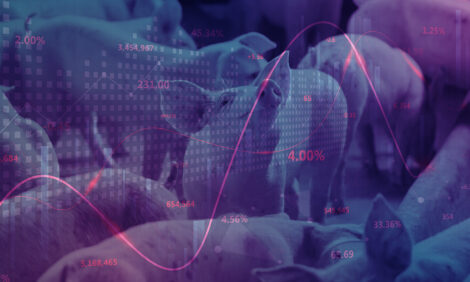



Considerations for the Large Group Housing of Pigs: Part 2
By the Prairie Swine Center - This is Part 2 of 4 of a special document outlining some considerations for the large groups housing of hogs.
IV. EQUIPMENT
Positives:
Less penning means less maintenance and replacement costs in the future
Reduced feed system cost and maintenance (i.e. reduced auger length since all feeders can be grouped in one area or at least on one side versus both sides of the barn)
Reduced water system delivery cost and maintenance (less pipe)
Reduced cost of ventilation equipment (i.e. may not need re-circulation system with less penning and because the pig chooses the most comfortable area to lie)
Adds equipment requiring more maintenance - sorter, compressor, scale, and electronics. In addition the system requires the installation of one-way gates from the feeding area to the common area.
Discussion:
It may be easier to achieve good operation of the ventilation system because pigs will find their comfort area. Auto sorters equipped with automatic spray markers could be used to identify pigs that are underweight for the current shipping event but that would probably be acceptable for the next shipping event, making it easier to predict shipping numbers for the next week’s shipping. Although the record of equipment performance has been good so far, most sources are less than three years into operation. Note that the sorter used for 500 hogs, making 3-4 trips through the sorter each day, results in the sorter operating 1750 times per day. If operated 365 days a year, this is approximately 640,000 sorting events – the life of the equipment for this level of usage is unknown.
The design of the facility will determine the equipment required. There are two basic forms of LGH management; Event Sort and Continuous Sort.
“Event Sort” - An event sort is a sort that is facilitated by the use of an auto sorter and is initiated by having the barn operator move the pigs towards and through the auto sorter such that all pigs in the large pen group are weighed and sorted. An individual pig will only travel through the sorter once per event. An event sort design requires less capital investment in the actual weighing and sorting equipment because it will sort perhaps as many as 1,000 pigs per sorter rather than 500 in a continuous sort system. (See Appendix, Figure 2)
Continuous Sort” - This is a process that occurs on an ongoing basis and is driven by the natural behaviour of the pig to move from the lying area of the room to the feeding area or watering area. Sorting using the continuous sort system allows separation for market weight, sorting for lights for special treatment, or phase feeding.
The portals that allow the pigs to return to the non-kitchen or resting area must be managed to ensure that they are working properly. If there is some restriction due to a blockage or mechanical failure, there will be a problem with overcrowding in the food court. (See Appendix Figures 1, 2, 3)
A. Equipment used in sorting
-
i) Gate: Return gate design continues to evolve.
Checklist:
- Consider robustness
- Trapping or injuring pigs
- Ease of operation for all weights of pigs
- Ensure that pigs can’t use it in reverse
- Potential for bruising near market weight
- Overcrowding in the sorting area could be a major problem
ii) Feeder:
Although we have changed the fundamental layout of the pen there is no indication to believe that feeder space allotment has to change. It is not clear if costs associated with feeder space that must be made available in LGH will decrease, remain neutral or increase. Design must include adequate feeder space available to the sick pen and the variable dimensions of the staging/holding area for near market weight pigs prior to shipment.
iii) Sorter Checklist:
- Strength
- Dependability
- Mechanical reliability
- reliability of software and electronic components
- ease of software operation for staff
- easy to clean
- provide protection for animals in the sorter
- location of weighing mechanisms (above the pig)
- location of sorter so that exit area is unrestricted (i.e. 8-10 foot separation between the exit gate and the nearest closest obstruction).
- operation and design of gates - there are several proven entry gate designs
- flexibility of sorting options with hardware/software (spray paint for color, moving gates, capping the number of pigs in a particular group)
- maintenance/cleaning requirements
- good dealer support
iv) Waterer: It is not evident from information available whether additional waterers are required when space is restricted. Access to water in the feeder or near the feeder is important to reduce the number of times the pig must exit and enter the feed court area to meet its daily needs.
V BUILDING COST
Positives:
Reduced cost of pen partitions
Reduced cost of unusable floor space associated with pen dividers
Reduced cost of floor space used as alleyways. (approximately 5% of floor space)
Reduced cost of augers and water lines when feeders and watering devices are concentrated in specific areas of the pen
Eliminates need for a dedicated shipping room which is present in some conventional barns
Possibility of reduction of cost in ventilation
A simpler ventilation system may serve a large group housing design (i.e. Because of better air distribution within the barn, it has been suggested that no re-circulation vent is required).
Construction costs of $25-$30 more per pig space for fully slatted over partially slatted design
This cost may be partially offset by higher stocking densities on slatted floors
Cost of automatic sorter
Discussion:
Not all pen partitions will be eliminated. It is recommended that some pens would continue to be available as sick pens, sort pens, market hog sorting and feed area segregation. Some stub walls or parking curbs could be made available as pigs prefer to sleep with their back against a wall or another pig.
Space that is normally set aside for handling, sorting or holding pigs will be made available to the pigs as they grow. The automatic sorter expense would be in the range of $6,500 to $10,000. It appears that the limits are approaching 500 pigs per automatic sorter. Dr. Mike Brumm, University of Nebraska, has suggested that possible savings of 0.5 sq ft per pig can be achieved in the LGH system because the pig can make better use of the space; for instance, less space is used for dunging compared to the percentage of space used in conventional pens.
VI. LABOUR/SKILLS
Positives:
There is reduced time spent in weighing of pigs with the use of automated sorting equipment. The job of weighing pigs has been identified as one of the least desirable jobs in the finishing barns.
There is reduced time required to check feeders and watering devices if concentrated into a specific feeding/watering area. This is especially advantageous at the beginning of the batch when numerous adjustments must be made to accommodate the new incoming pigs and another unpleasant job is eliminated.
Reduced time spent climbing over partitions or opening gates to access pigs encourages more thorough and frequent observation of the pigs. This may translate into more quality time available for herd health.
Time spent in washing the room is reduced because of fewer pen partitions.
Predicting the number of pigs to ship each week is easier because more data is available on pig weights.
Reduced risk of injury to stock people from handling market weight hogs at weighing.
Maintenance could be more difficult with pigs still in the pens. There is no opportunity to empty an individual pen in which maintenance is required.
Pigs "swarm" around the operator as they are working in the pen. Some people find large groups of pigs to be intimidating.
Training methods will be required as barn operators become accustomed to observing and handling pigs in larger groups.
Removing a single pig from these large groups may be more time consuming.
Removing dead pigs may be more difficult.
The use of the fully slatted floor may contribute to increased ammonia on average and this may be a labour issue in the future.
Training requirements are needed to acquire a different skill set and workers have to embrace the technology.
Training of pigs to use the sorter will be an added responsibility of stockperson
VII OPERATING COSTS
Positives:
Reduced labour costs are associated with weighing, sorting, washing and maintenance of pens
Reduced wash water volume associated with less penning
It is easier to restrict feed, resulting in reduced cost of feed in the pig’s gut at the time of shipping (approx. 3 kg)
Sprinkler systems used for establishing dunging patterns could be eliminated
Reduced maintenance on equipment, especially penning
- Maintenance costs may possibly increase, depending on sorter and return gates
Further information
To read Part 1 please click here
To read Part 3 please click here
Source - Prairie Swine Centre - August 2004








